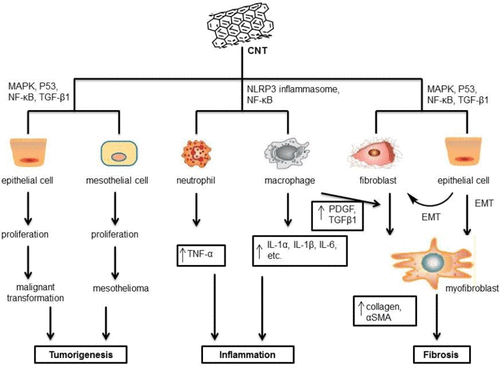当前位置:
X-MOL 学术
›
Chem. Res. Toxicol.
›
论文详情
Our official English website, www.x-mol.net, welcomes your
feedback! (Note: you will need to create a separate account there.)
Toxicity of Carbon Nanotubes: Molecular Mechanisms, Signaling Cascades, and Remedies in Biomedical Applications
Chemical Research in Toxicology ( IF 3.7 ) Pub Date : 2020-12-15 , DOI: 10.1021/acs.chemrestox.0c00172 Mansab Ali Saleemi 1 , Mohammad Hosseini Fouladi 2 , Phelim Voon Chen Yong 1 , Karuthan Chinna 3 , Navindra Kumari Palanisamy 4 , Eng Hwa Wong 3
Chemical Research in Toxicology ( IF 3.7 ) Pub Date : 2020-12-15 , DOI: 10.1021/acs.chemrestox.0c00172 Mansab Ali Saleemi 1 , Mohammad Hosseini Fouladi 2 , Phelim Voon Chen Yong 1 , Karuthan Chinna 3 , Navindra Kumari Palanisamy 4 , Eng Hwa Wong 3
Affiliation

|
Carbon nanotubes (CNTs) are the most studied allotropic form of carbon. They can be used in various biomedical applications due to their novel physicochemical properties. In particular, the small size of CNTs, with a large surface area per unit volume, has a considerable impact on their toxicity. Despite of the use of CNTs in various applications, toxicity is a big problem that requires more research. In this Review, we discuss the toxicity of CNTs and the associated mechanisms. Physicochemical factors, such as metal impurities, length, size, solubilizing agents, CNTs functionalization, and agglomeration, that may lead to oxidative stress, toxic signaling pathways, and potential ways to control these mechanisms are also discussed. Moreover, with the latest mechanistic evidence described in this Review, we expect to give new insights into CNTs’ toxicological effects at the molecular level and provide new clues for the mitigation of harmful effects emerging from exposure to CNTs.
中文翻译:

碳纳米管的毒性:生物医学应用中的分子机制、信号级联和补救措施
碳纳米管 (CNT) 是研究最多的碳的同素异形体形式。由于其新颖的物理化学特性,它们可用于各种生物医学应用。特别是体积小、单位体积表面积大的碳纳米管对其毒性有相当大的影响。尽管在各种应用中使用了碳纳米管,但毒性是一个需要更多研究的大问题。在这篇综述中,我们讨论了碳纳米管的毒性和相关机制。还讨论了可能导致氧化应激、毒性信号通路和控制这些机制的潜在方法的物理化学因素,例如金属杂质、长度、尺寸、增溶剂、碳纳米管功能化和团聚。此外,根据本综述中描述的最新机制证据,
更新日期:2021-01-18
中文翻译:

碳纳米管的毒性:生物医学应用中的分子机制、信号级联和补救措施
碳纳米管 (CNT) 是研究最多的碳的同素异形体形式。由于其新颖的物理化学特性,它们可用于各种生物医学应用。特别是体积小、单位体积表面积大的碳纳米管对其毒性有相当大的影响。尽管在各种应用中使用了碳纳米管,但毒性是一个需要更多研究的大问题。在这篇综述中,我们讨论了碳纳米管的毒性和相关机制。还讨论了可能导致氧化应激、毒性信号通路和控制这些机制的潜在方法的物理化学因素,例如金属杂质、长度、尺寸、增溶剂、碳纳米管功能化和团聚。此外,根据本综述中描述的最新机制证据,











































 京公网安备 11010802027423号
京公网安备 11010802027423号